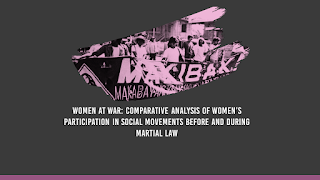The Fash with Fashionalism
Fashionalism, a portmanteau of FASHION and NATIONALISM
seems to have established its place in the Philippine fashion industry. The
term from Rhett Eala who created a collection of collared shirts and polos for
the brand Collezione C2 using the Philippine archipelago for its main design. From polo shirts that bear the map of the
Philippines to the more formal terno or Filipiniana, the trend of fashionalism
has been on the rise. The “Pinoy Pride” sensation became an effective way of
pronouncing one's nationalism - identifying oneself through these commodities.
Regionalism or tribalism is the consciousness or in group loyalty through
possession of a strong cultural or ethnic identity. This best explains its
success to the Filipino consumers.
With its claim to fame by peaking our Filipino
identity and consciousness, those who support fashionalism often argue that
through it, we are making history and nationalism more viable and marketable to
the youth. Those who were not familiar with Philippine historical, cultural and
pop icons would be able to do so. It is also a way to preserve culture – by
turning and embedding them into bags, shirts, wallets and many more kinds of
merchandise.
Unfortunately, many also counter these claims as fashionalism
stays as a tokenistic action to the bigger call of displaying nationalism
through a more aggressive form - demonstrations and and rallies rooted from the
very definition of our love of country. For example, the very thread and needle
used to make these apparels are outsourced – almost all of the raw materials
are from somewhere cheaper so that the cost of mass production would not hurt.
That alone defeats the purpose of being nationalist. The Filipiniana as another
example can actually be seen as oppressive because it is contributing further
in embedding the gender roles and stereotypes of women just like what the burqa
does for those who wear them. These restrict movement and choice and can only
be worn by a true “dalagang Pilipina”. Novelty
shirts also became a favorite for politicians. Often seen being worn during
campaigns. It projects an identity of patriotism that if they win, would serve
the country wholeheartedly or cleanly sans corruption. Fashion then served as a
propaganda material during these times and is very evident for example with
Grace Poe. As a candidate, she was always seen in white polos that projects a
clean character. Meanwhile, former president Noynoy Aquino is always seen
wearing polo shirts in black or yellow with the yellow ribbon or the map of the
Philippines in its chest. This only proves that fashionalism became a token to
reduce nationalism into just wearing clothes. That by wearing these shirts, we
have already done our job showing patriotic fervor, self-expression and
freedom.
And so where do we draw the line? Isn’t fashionalism
an innovative way of culturally preserving and promoting the Filipino
culture? While it is innovative and
could positively engage and educate the youth about our history by
familiarizing them, it should not be the be all and end all of nationalism. If
we truly wanted to be nationalist, there’s a bigger picture we need to see. If
we wanted to preserve our culture then we should address the conflicts and
problems brought to our indigenous people. More than anything, we need to
imbibe the love of country not just through threads but more so with deeds that
these actions would amount to something in return.
REFERENCES:
Chavez, J.(22 April 2016). Fashionalism. Sociology of
Fashion. Retrieved from sociologyofashion.com/fashioning-nations/fashionalism/
Philippine Online Chronicles (16 June 2010). Fashionalism:
Real nationalism or a mere trend?. Philippine Online Chronicles. Retrieved from
http://thepoc.net/index.php/fashionalism-real-nationalism-or-a-mere-trend/
Stevens, R. (01 June 2009). Awakening Our
Fashionalism. Onya Magazine. Retrieved from https://www.onyamagazine.com/fashion/fashion-factor/awakening-our-fashionalism/

Comments
Post a Comment